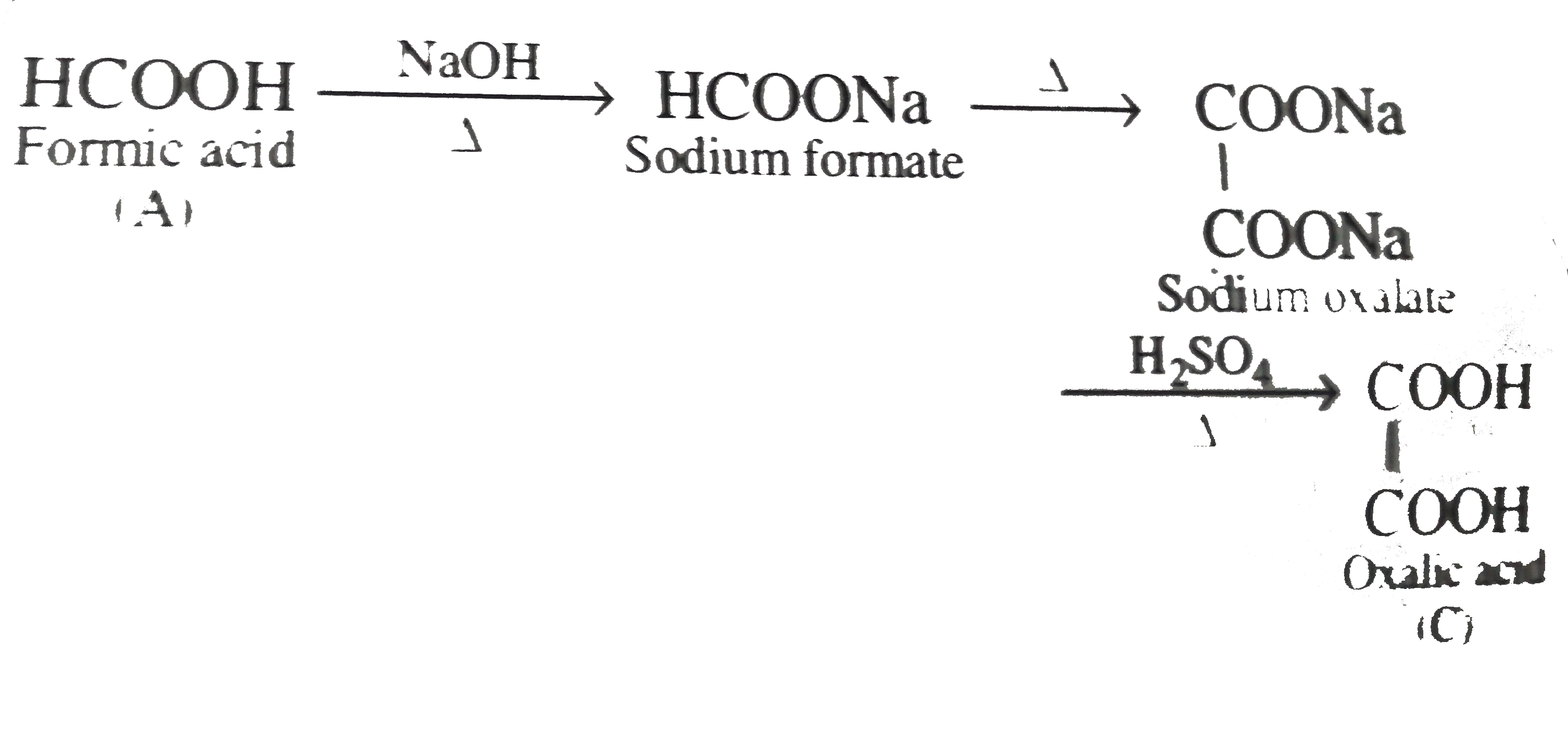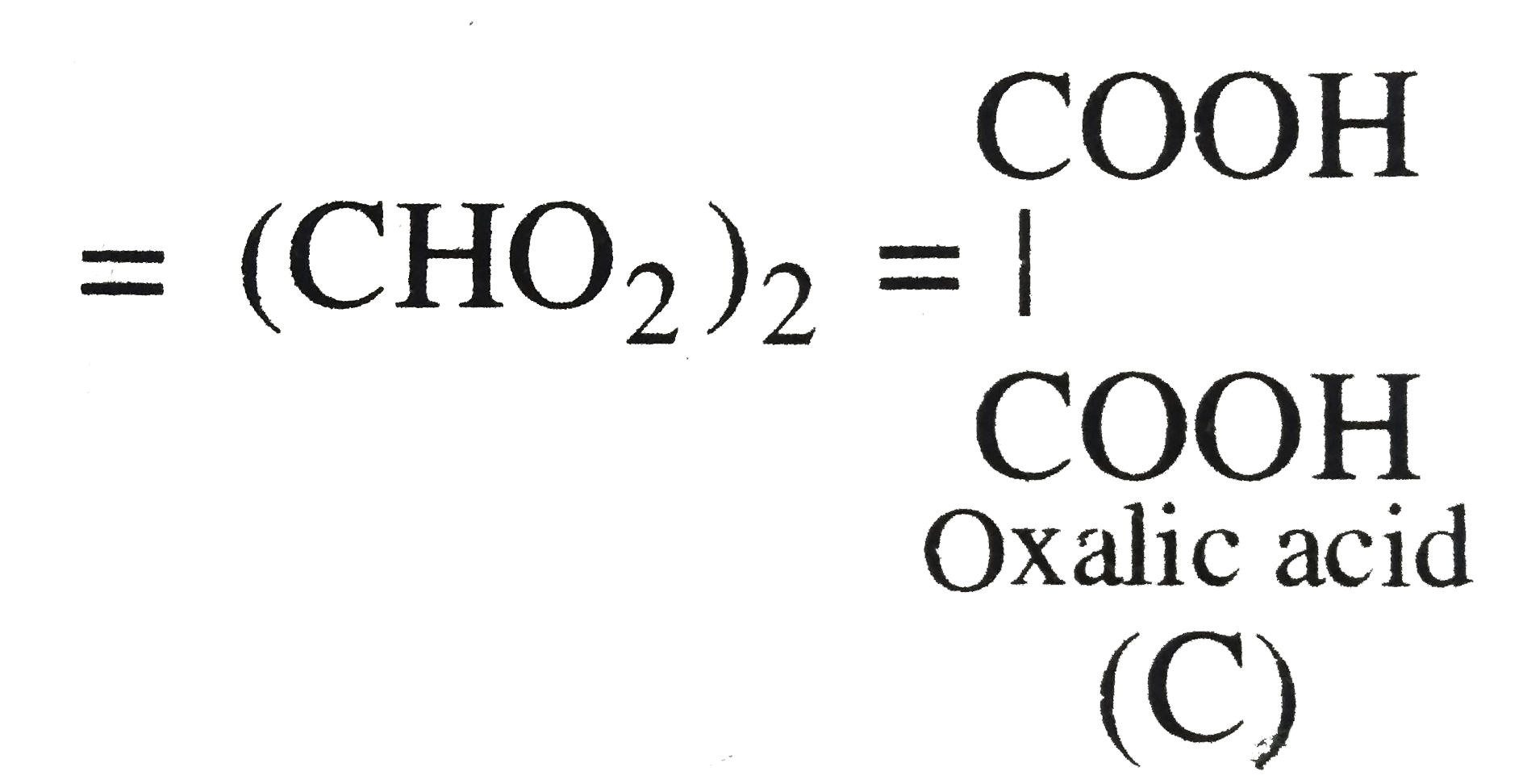The sodium salt of a carboxylic acid (A) was produced by passing a gas (B) into an aqueous solution of caustic alkali at an envolved temperature and pressure (A) on heating in the presence of sodium hydroxide followed by the treatment with sulphuric acid gave a dibasic acid (C). A sample of 0.4gm of acid (C) on combustion gave 0.08gm of water and weighting 1.0gm on ignition yielded 0.71gm of silver as residue. Identify (A),(B), and (C).
(i) Gas(B)+NaOHHigh.P,T−−−−−−→RCOONa
This is characteristic reaction of CO2 with NaOH to give sodium formate.
CO2(B)+NaOHHigh−−→P,THCOONaH2O−−→HCOOH(A)
(ii) (A) on heating in the presence of NaOH followed with H2SO4 gives a dibasic acid (C).
 .
.
(iii) The data given for (C) also confirms that it is oxalic acid.
∣∣
∣
∣
∣
∣
∣
∣
∣∣ElementPercentageRelative no of atomsSimplest ratio=Percentageat. massC1244×0.390.40×100=26.5926.5912=2.211H218×0.080.40×100=2.222.221=2.221O100−(26.59+2.22)=71.1971.1916=4.442∣∣
∣
∣
∣
∣
∣
∣
∣∣
∴ Empirical formula of (C) is CHO2.
Empirical wt.45
Also, Mw of (C) is
Wt.ofAgEwofAg=Wt. of Ag saltE+108
(where E is the Ew of anion of acid)
0.71108=1E+108
∴E=44 (i.e., Ew of anion of acid)
∴Ew of acid =44+1=45
Mw of acid =90
∴n=MwEmpirical formula wt.=9045=2
Molecule formula, =(Empirical formula)n

Topper's Solved these Questions
- CARBOXYLIC ACIDS AND THEIR DERIVATIVESBOOK - CENGAGE CHEMISTRYCHAPTER - CARBOXYLIC ACIDS AND THEIR DERIVATIVESEXERCISE - Exercises Archives (True/False)
2 Videos
- BIOMOLECULES, POLYMERS AND CHEMISTRY IN EVERYDAY LIFEBOOK - CENGAGE CHEMISTRYCHAPTER - BIOMOLECULES, POLYMERS AND CHEMISTRY IN EVERYDAY LIFEEXERCISE - QUESTION BANK
8 Videos
- CHEMICAL KINETICSBOOK - CENGAGE CHEMISTRYCHAPTER - CHEMICAL KINETICSEXERCISE - Archives Subjective
23 Videos
Similar Questions
The sodium salt of a carboxylic acid (A) was produced by passing a gas (B) into an aqueous solution of caustic alkali at an envolved temperature and pressure (A) on heating in the presence of sodium hydroxide followed by the treatment with sulphuric acid gave a dibasic acid (C). A sample of 0.4gm of acid (C) on combustion gave 0.08gm of water,.39gm of CO2 and weighting 1.0gm on ignition yielded 0.71gm of silver as residue. Identify (A),(B), and (C).
View SolutionThe salt obtained by partial neutralisation of sodium hydroxide and sulphuric acid is ______ in nature
View Solution
Knowledge Check
Sodium salts of carboxylic acids on heating with soda lime give
AalkeneBalkanesCetheneDbenzeneSodium salt of benzene sulphonic acid on fusion with caustic soda and followed by treatment with HCl gives
Aacetic acidBCumeneCphenolDpicric acidSodium salt of benzene sulphonic acid on fusion with caustic soda and followed by treatment with HCI gives
Aacetic acidBcumeneCphenolDpicric acid
A mixture of sodium chloride and sodium iodide when treated with sulphuric acid gave sodium sulphate equal to the weight of the original mixture. Find the percentage composition of the mixture.
View SolutionAqueous solution of orthoboric acid can be titrated against sodium hydroxide using phenolphthalein indicator only in presence of
View SolutionAqueous solution of orthoboric acid can be titrated against sodium hydroxide using phenolphthalein indicator only in presence of :
View Solution0.701 g of silver salt of a dibasic acid on ignition yielded 0.497 g of metallic silver. Molecular weight of the acid is (Ag = 108)
View SolutionThe metal, which gives hydrogen on treatment with acid as well as sodium hydroxide is
View Solution